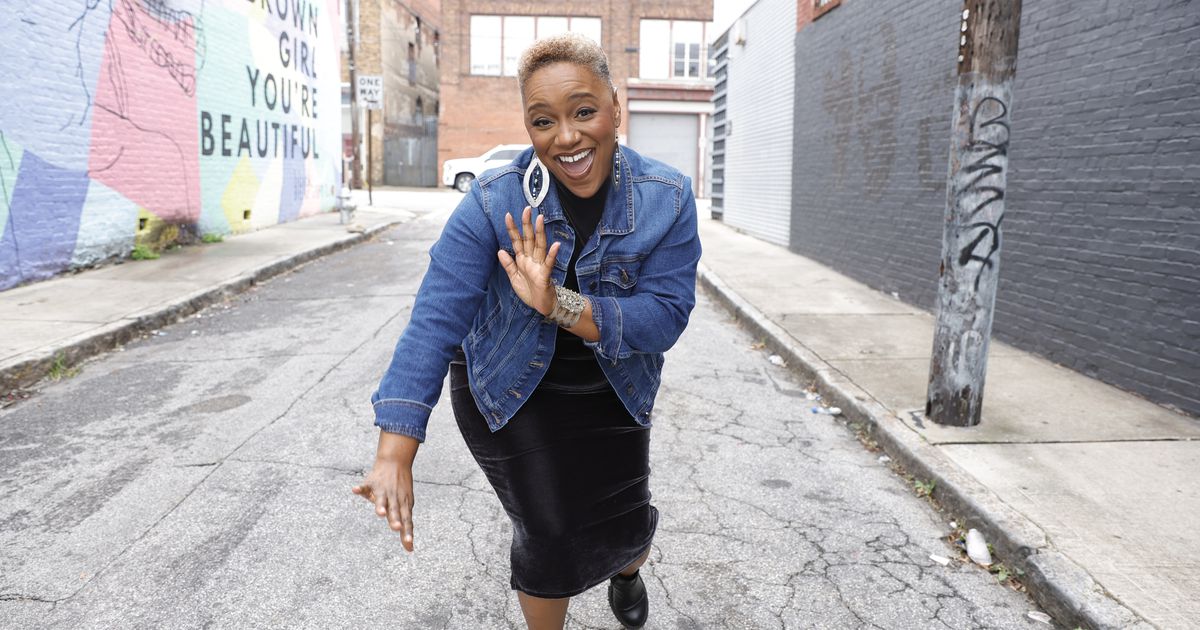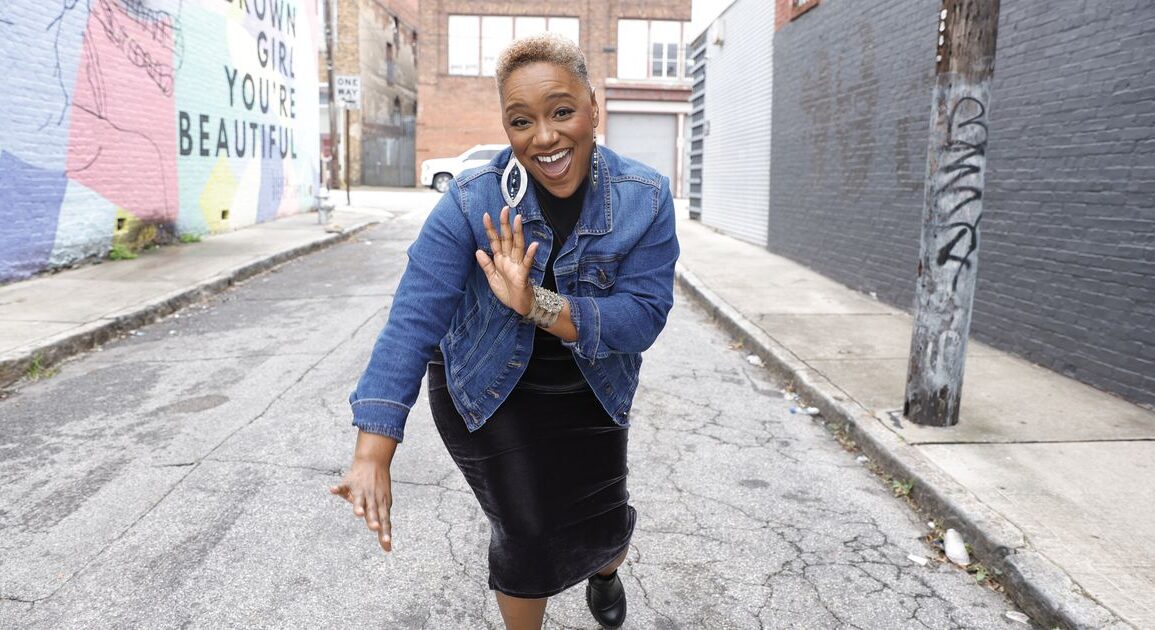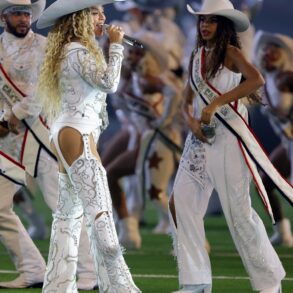
Her first teacher was her mother, Billie Ann Gaither, who in the 1960s opened the Gaither School of Dance, one of the first Black-owned dance schools in Georgia.
Growing up, she mastered many styles, from ballet and jazz to traditional African dance. On a chance audition, the then-13-year-old joined seminal Atlanta rap group Arrested Development as its principal dancer.
Credit: Georgia State University
Credit: Georgia State University
“We started traveling, I would sing, I would dance, play instruments, whatever was needed to make the show great,” said Eshe.
On the 50th anniversary of hip-hop, while the music has always been the centerpiece, other aspects like dance are as important. In many instances, the dance moves accompanying the music have become more popular than the actual song. Rising out of community centers, high schools and skating rinks, organized dance crews gave Atlanta the Bankhead Bounce and the Yeek, just to name a few.
Those hangout spots were also frequent destinations for a future Atlanta mayor and a host of music luminaries from Jermaine Dupri to Dallas Austin.
“Atlanta is not afraid to dance,” said Joycelyn Wilson, a Georgia Tech assistant professor whose research includes African American expressive traditions. “That is something that’s really unique to Atlanta hip-hop.”
This year marks the 50th anniversary of hip-hop, a cultural phenomenon that sparked a groundbreaking musical genre. Although Atlanta’s emcees may have picked up the mic nearly a decade after the movement was birthed in Bronx, New York, ATL’s influence is undeniable. The Atlanta Journal-Constitution is celebrating the city’s influence with the upcoming premiere of “The South Got Something To Say,” an insightful documentary on Atlanta’s rise in hip-hop. Accompanied by a monthlong, 14-story series, the AJC is exploring how Atlanta cemented its spot in hip-hop history. Follow along online, in print and in the Unapologetically ATL newsletter.
Atlanta has not only become a center for hip-hop, but it’s also a dance craze mecca. And it’s not showing any signs of slowing down.
“Hip-hop culture is not just music; it is the outfits, it’s the look, it’s the fashion,” said dancer Brandi Barnett. “It’s dance too.”
And it’s the places.
Barnett, the co-owner and director of the Fayetteville dance studio SkyDance Academy, started dancing at a young age. She was only 3 when her mother put her and her two sisters in classes. Calling it a natural talent, she was the only one who stuck with dancing.
Credit: Courtesy: Brandi Barnett
Credit: Courtesy: Brandi Barnett
Barnett, who grew up in the College Park area, continued honing her skills in the dance program at Tri-Cities High School and in a home dance studio, participating in recitals and competitions. She learned many forms including tap, jazz, ballet and hip-hop.
When Barnett wasn’t competing, you could find her at the skating rink, where hip-hop was a steady soundtrack.
She remembers spending time at SkateTowne on Old National Highway wearing a typical 90′s getup. She describes a mix of outfits, one being a crop top and overalls, with K-Swiss or Reebok Classic sneakers.
“Dance, it’s a language of the body, but it’s what you see,” Barnett said. “So it’s how you look, it’s your costume.”
“It was a thing that you did every Friday,” Barnett said. “But even if you were not skating you were dancing, like that was our club.”
Skating rinks, particularly the now-closed Jelly Beans, was a safe space, said Wilson, who used to visit it often. There was no real concern about violence, she said, but rather a place to show up and have a good time. Dance crews practiced and performed there, she said.
“We have a really big skate culture, especially with Cascade, Golden Glide,” said Adeerya Johnson, a doctoral student at the University of British Columbia studying Southern hip-hop dance culture. In skating rinks, there’s a transformation of taking off skates, but doing similar skate-like movements on the dance floor, the Decatur native said.
Eshe also remembers going to the Jelly Beans skating rink in Southwest Atlanta.
“It was iconic, because let me tell you something,” Eshe said. “On Sundays, we would shut that thing down, you hear me. I mean people would be up in there until two or three in the morning just dancing.”
Austin, one of Atlanta’s premier producers who crafted TLC’s earliest hits and launched the careers of other Atlanta artists such as R&B singer Monica and Another Bad Creation, said the skating rink was the place where everything was happening.
The roller rink is so embedded into Atlanta’s hip-hop scene that it inspired the 2006 film “ATL,” which is loosely based on Austin’s experiences there. He produced the film, which starred Atlanta rappers T.I. and Big Boi.
“The skating rink was a primary outlet for us before the strip club because we were all young enough to go there,” Austin told The AJC for “The South Got Something To Say” documentary, which is streaming in November. “Countless people either were over there dancing in that part or we were skating on this part. It was like a culture box.”
Barnett’s head instinctively bobbed when she recalled the lyrics to “Wassup, Wassup,” by the A-Town Players.
Released in 1995, the song started one of Atlanta’s first dance crazes, the Bankhead Bounce, which originated in the Westside neighborhood.
“Wassup wassup, wassup wassup wassup, uh do the Bankhead bounce, uh that Bankhead bounce,” the song goes.
Barnett said you could make it your own by coupling it with outside hobbies, like swinging a baseball bat while moving your shoulders up and down.
“Whatever you want it to interpret or portray, you can do it with the Bankhead Bounce,” she said.
Barnett really knew Atlanta was on the map when the Bankhead Bounce blew up, she said. Even Michael Jackson incorporated it into his performances.
But before the Bankhead Bounce, there was a dance that also became an Atlanta-born sensation: the Yeek.
Describing the dance as a movement, Barnett said yeeking was a major part of Atlanta’s culture.
“We grew up yeeking in Atlanta,” Eshe said. “I mean, we’d be packed up in [Jelly Beans] like sardines just yeeking.”
Yeeking generally involves dancers moving their legs from side to side at the speed of thumping bass music. They raise their arms at the climax of the bass sound and scream, “Yeek!”
“It was like ‘Yeek!’ then it was like boom, shake it up, then ‘Yeek!’,” Barnett said, showing the movements.
“The louder the yeek, the better the dance routine,” Wilson said.
One popular dance crew that specialized in the Yeek called themselves “Off Limits.” A young Andre Dickens, who was a student at Benjamin E. Mays High School, was part of the group.
“It was a fun time to be alive because the music was everything,” Dickens, now Atlanta mayor, said for the AJC’s documentary. “You know, you go to school by day, go to practice at night,” he said. “I always ended up in somebody’s basement practicing a dance routine to get ready to battle.”
“Could I Yeek today?” the mayor asked in the AJC documentary rhetorically. “Yeah. But the way my knees and back are, I couldn’t do it for too long. Those dances cost you a whole lot of energy.”
But nearly every weekend back then, the future mayor and his dance crew dressed like doctors, baseball players or got decked-out in overalls, and would compete in talent competitions.
“You can’t be a dance crew and not be dressed alike,” Wilson said. “Fashion is one other way in which folks are expressing themselves through the dance and through the sound and through the lyrics.”
Johnson said that dances like the Bankhead Bounce and the Yeek represent important moments in Southern hip-hop dance culture.
“The cool thing about yeeking is it ties back into these origins of hip-hop, so Black folks coming together, to find a place, hang out and just express themselves,” Johnson said.
Then, came the 2000s.
A new hip-hop culture started in Atlanta, and so with it came new dances.
This era brought a fresh sound, one that could only come from the South. Crunk music, a subgenre of hip-hop that began in Memphis, encouraged a “hype, mosh pit type of dance,” Johnson said.
It evolved when crunk music moved to Atlanta. Once Lil Jon & The East Side Boyz emerged, Johnson said, the sounds encouraged audiences to “get hype” and “rep their region.”
Later in the 2000s, Atlanta hip-hop artists ushered in the “snap” style of rap.
This includes rap acts like Lil Jon & The East Side Boyz, along with Yung Joc, Dem Franchize Boyz, Young Dro, DJ Unk and Soulja Boy.
With the snap era came dances like “the Snap” and “Walk It Out.”
“Walk It Out” was originally called the Poole Palace, named after the now-closed venue in Bankhead.
Other moves, such as “the Motorcycle,” “2-Step,” and “Crank Dat,” also surfaced during the 2000s decade.
The motorcycle, like the yeek, also involves moving at the speed of thumping bass music. To songs like, “It’s Goin Down” by Yung Joc, dancers lean left to right, bouncing their shoulders and hands as if cranking a motorcycle.
The snap — also known as lean with it, rock with it — requires you to sway from left to right while snapping your fingers. At the apex of each lean, you hit the snap.
“When it comes to the birth of snap, you’re getting songs that are literally just telling you to lean, snap, roll, bounce,” Johnson said.
The world quickly caught on. Soulja Boy’s “Crank That” was one of the first dances — although a bit more complex — that spread throughout the internet. YouTube helped immensely, Wilson noted.
Like many popular dance crazes, Atlanta’s best-known trends are heavily influenced by call and response orders in the music, Wilson said.
“You know when to do it (the dance) in the song and there’s a call for it,” Wilson said. “The listener and the crowd knows when to respond and when they do, it’s done in unison.”
The 2010s brought its own dances with the use of the internet and social media. Videos showed groups of people simply performing viral moves in neighborhoods and schools. Individuals would come up one by one and dance, while the others would hype them up while energetically watching in the background.
It was a period when artists made songs specifically for a dance to go along with it.
In 2013, the song, “Beef It Up,” by Charlie Boy Gang popularized the dance of the same name, and We Are Toonz popularized the Nae Nae dance.
In 2015, at least three dances swept through Atlanta and eventually the nation. Artists like the Migos, Silento and Bankroll Fresh put a spotlight on the Dab, the Whip and Hit Dem Folks, respectively.
Popular dances continue to make their way to culture in other ways on social media.
One of the first viral dances from TikTok was made by a metro Atlanta teenager, Jalaiah Harmon.
Credit: Michael Rozman
Credit: Michael Rozman
In 2020, a 14-year-old Harmon, made the Renegade dance, based on the song, “Renegade,” by Atlanta rapper K Camp. At the time, Harmon was a student at Barnett’s dance studio in Fayetteville.
She originally posted the dance on Instagram, but it blew up on TikTok.
“On Instagram it was just a normal thing,” Harmon said. “When it got to TikTok, that’s when it went viral.”
The dance was so popular that other TikTok creators started doing it, and Harmon wasn’t given the credit for choreographing it.
“It’s going viral and I’m not getting recognized for it,” she said. “It just made me feel a little down.”
Barnett, who was Harmon’s dance teacher at the time, said she was excited that Harmon’s routine was well-received but it is a reflection of how Black artists can be treated.
“She was this Black girl who created something,” Barnett said, but she wasn’t getting her recognition, as other Black artists have experienced before.
“Atlanta has always had a dance culture associated with its music,” Wilson said. “Atlanta is in the driver’s seat of all things hip-hop, and, of course the attention is on the city, so the dances get some of that attention.”
Barnett said dance is in a new season with TikTok. The steps aren’t traditional, but instead revamped, she said.
And it’s a good thing.
Eshe said Atlanta dance has brought the generations together and has given hip-hop a Southern flavor.
“I feel like a lot of Atlanta dances is something that everybody can do,” she said. “It’s definitely brought some spice to the culture.”
This post was originally published on this site be sure to check out more of their content.









